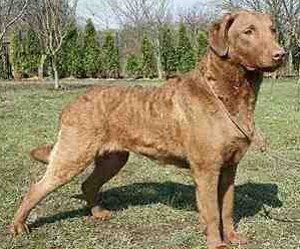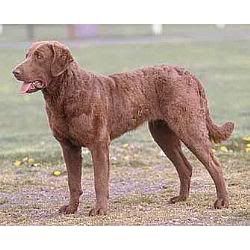Post by DogGoneGood on Sept 28, 2008 12:37:52 GMT -5
Group: 1 - Sporting
Origin: United States of America
Purpose: Tracking, Pointing and Retrieving

General Appearance: The Chesapeake dog should show a bright and happy disposition and an intelligent expression, with general outlines impressive and denoting a good worker. The dog should be well proportioned, a dog with a good coat and well balanced in other points being preferable to the dog excelling in some but weak in others.
The texture of the dog's coat is very important, as the dog is used for hunting under all sorts of adverse weather conditions, often working in ice and snow. The oil in the harsh outer coat and woolly undercoat is of extreme value in preventing the cold water from reaching the dog's skin and aids in quick drying. A Chesapeake's coat should resist the water in the same way that a duck's feathers do. When he leaves the water and shakes himself, his coat should not hold the water at all, being merely moist.
Colour and coat are extremely important, as the dog is used for duck hunting. The coat must be as nearly that of his surroundings as possible and with the fact that dogs are exposed to all kinds of adverse weather conditions, often working in ice and snow, the colour of coat and its texture must be given every consideration when judging on the bench or in the ring.
Size:
Weight: males, 65-75 lb. (29-34 kg.); females, 55-65 lb. (25-29 kg).
Height: males, 23-26 in. (58-66 cm); females, 21-24 in. (53-61 cm).
Tail: Should be medium length, varying from: males, 12-15 in. (30-38 cm) and females, 11-14 in. (28-36 cm). Medium heavy at base, moderate feathering on stern and tail permissible.
Head: Skull broad and round with medium stop, nose medium short, muzzle pointed but not sharp, Lips thin, not pendulous. Eyes medium large, very clear, of yellowish colour and wide apart. Ears small, set well upon head, handing loosely and of medium leather.
Neck: Of medium length with a strong muscular appearance, tapering to shoulders.
Forequarters: Shoulders sloping and should have full liberty of action with plenty of power without any restrictions of movement. Legs should be medium length and straight, showing good bone and muscle; pasterns slightly bent and of medium length.
Hindquarters: Back quarters should be as high or a trifle higher than the shoulders. They should show fully as much power as the forequarters. There should be no tendency to weakness in either fore or hindquarters. hindquarters should be especially powerful to supply the driving power for swimming. Good hindquarters are essential. Hocks of medium length, with well-webbed hare feet of good size. The toes well rounded and close. The straighter the legs the better.
Body: Chest strong, deep and wide. Barrel-round and deep. Body of medium length, neither cobby nor roached, but rather approaching hollowness, flanks well tucked up. Back should be short, well coupled and powerful.
Coat and Colour: Coat should be thick and short, nowhere over 12 in. (4 cm) long, with a dense fine woolly undercoat. Hair on face and legs should be very short and straight with tendency to wave on the shoulders, neck, back, and loins only. The curly coat or coat with a tendency to curl not permissible. Any colour varying from a dark brown to a faded tan or deadgrass. Deadgrass takes in any shade of deadgrass, varying from a tan to a dull straw colour. White spot on breast and toes permissible, but the smaller the spot the better, solid colour being preferred.
Temperment: Courage, willingness to work, alertness, nose, intelligence, love of water, general quality, and, most of all, disposition should be given primary consideration in the selection and breeding of the Chesapeake Bay dog.
Faults: Black or liver coloured. White on any part of the body, except breast, belly or spots on feet. Feathering on tail or legs over 1" in. (4.5 cm) long. Dewclaws on hind legs, undershot, overshot or any deformity. Coat curly or tendency to curl all over body. Specimens unworthy or lacking in breed characteristics.

Sources:
Canada's Guide to Dogs - Canadian Kennel Club Breed Standard For the Chesapeake Bay Retriever
Origin: United States of America
Purpose: Tracking, Pointing and Retrieving

General Appearance: The Chesapeake dog should show a bright and happy disposition and an intelligent expression, with general outlines impressive and denoting a good worker. The dog should be well proportioned, a dog with a good coat and well balanced in other points being preferable to the dog excelling in some but weak in others.
The texture of the dog's coat is very important, as the dog is used for hunting under all sorts of adverse weather conditions, often working in ice and snow. The oil in the harsh outer coat and woolly undercoat is of extreme value in preventing the cold water from reaching the dog's skin and aids in quick drying. A Chesapeake's coat should resist the water in the same way that a duck's feathers do. When he leaves the water and shakes himself, his coat should not hold the water at all, being merely moist.
Colour and coat are extremely important, as the dog is used for duck hunting. The coat must be as nearly that of his surroundings as possible and with the fact that dogs are exposed to all kinds of adverse weather conditions, often working in ice and snow, the colour of coat and its texture must be given every consideration when judging on the bench or in the ring.
Size:
Weight: males, 65-75 lb. (29-34 kg.); females, 55-65 lb. (25-29 kg).
Height: males, 23-26 in. (58-66 cm); females, 21-24 in. (53-61 cm).
Tail: Should be medium length, varying from: males, 12-15 in. (30-38 cm) and females, 11-14 in. (28-36 cm). Medium heavy at base, moderate feathering on stern and tail permissible.
Head: Skull broad and round with medium stop, nose medium short, muzzle pointed but not sharp, Lips thin, not pendulous. Eyes medium large, very clear, of yellowish colour and wide apart. Ears small, set well upon head, handing loosely and of medium leather.
Neck: Of medium length with a strong muscular appearance, tapering to shoulders.
Forequarters: Shoulders sloping and should have full liberty of action with plenty of power without any restrictions of movement. Legs should be medium length and straight, showing good bone and muscle; pasterns slightly bent and of medium length.
Hindquarters: Back quarters should be as high or a trifle higher than the shoulders. They should show fully as much power as the forequarters. There should be no tendency to weakness in either fore or hindquarters. hindquarters should be especially powerful to supply the driving power for swimming. Good hindquarters are essential. Hocks of medium length, with well-webbed hare feet of good size. The toes well rounded and close. The straighter the legs the better.
Body: Chest strong, deep and wide. Barrel-round and deep. Body of medium length, neither cobby nor roached, but rather approaching hollowness, flanks well tucked up. Back should be short, well coupled and powerful.
Coat and Colour: Coat should be thick and short, nowhere over 12 in. (4 cm) long, with a dense fine woolly undercoat. Hair on face and legs should be very short and straight with tendency to wave on the shoulders, neck, back, and loins only. The curly coat or coat with a tendency to curl not permissible. Any colour varying from a dark brown to a faded tan or deadgrass. Deadgrass takes in any shade of deadgrass, varying from a tan to a dull straw colour. White spot on breast and toes permissible, but the smaller the spot the better, solid colour being preferred.
Temperment: Courage, willingness to work, alertness, nose, intelligence, love of water, general quality, and, most of all, disposition should be given primary consideration in the selection and breeding of the Chesapeake Bay dog.
Faults: Black or liver coloured. White on any part of the body, except breast, belly or spots on feet. Feathering on tail or legs over 1" in. (4.5 cm) long. Dewclaws on hind legs, undershot, overshot or any deformity. Coat curly or tendency to curl all over body. Specimens unworthy or lacking in breed characteristics.

Sources:
Canada's Guide to Dogs - Canadian Kennel Club Breed Standard For the Chesapeake Bay Retriever

